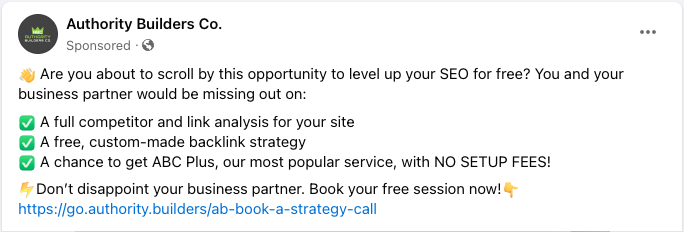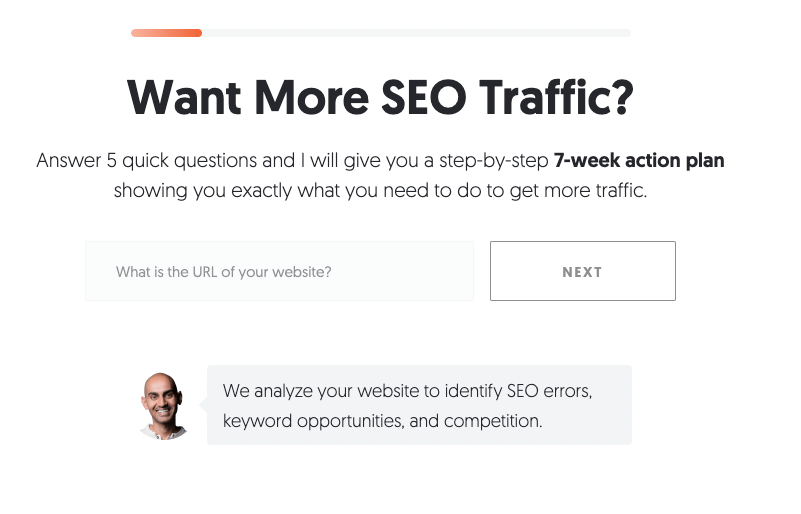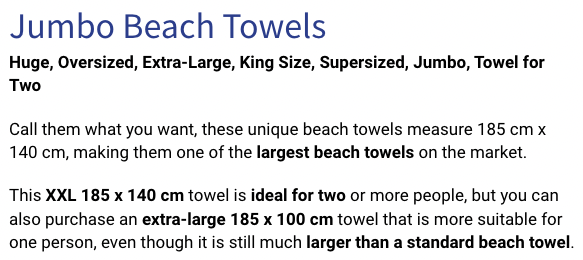Copywriting and SEO copywriting are two closely related disciplines. In fact, they’re so closely related many people confuse the two. While both copywriting and SEO copywriting share many similarities, the primary objective is different for each.
Copywriting focuses on crafting a compelling message that motivates the target audience to take a specific action, such as making a purchase or signing up for a service. On the other hand, SEO copywriting aims to improve search engine rankings and drive targeted traffic by incorporating relevant keywords and phrases organically within the content.
If you’re still confused, keep reading. In this article, I’ll explain what copywriting and SEO copywriting are in more detail, and provide real-world examples of both to help you understand the difference.
Let’s get started with…
What Is Copywriting?
Copywriting, or direct response copywriting as it’s often referred to, is the art of creating written content that’s designed to persuade the reader to take a desired action. Copywriting is widely used in advertising and marketing to promote products or services and convince people to purchase them.
The goal of a skilled copywriter is to create a message that is compelling, memorable, and effective in achieving the desired outcome. This can include writing headlines, slogans, landing pages, emails, social media posts, and more.
Copywriting involves understanding the target audience and crafting messages that resonate with their needs, wants, and desires. This requires a deep understanding of the product or service being offered, as well as the language and communication style that will be most effective in reaching and engaging the target audience.
Copywriting can be both an art and a science, as it requires a balance of creativity and strategic thinking to create content that is impactful and measurable. It is an essential component of any marketing or advertising campaign and can have a significant impact on the success of a business or brand.
Copywriting Examples
OK, so that’s the definition out of the way. But what does copywriting look like in practice? Here are some examples of good copywriting used in various forms of advertising and marketing (side note: if you want some examples of bad copywriting, go here):
Email Copywriting
The copy in emails is written to persuade readers to take action – whether that’s an intriguing subject line that convinces you to open it, or the text in the email that gets you to visit a store.
Because your inbox sorts emails by time and date, rather than what’s inside, there’s no need to write SEO copy inside. Instead, the idea is to catch attention and get people across to your website.
Here are some subject line examples in my inbox, all competing for my attention:

Social Media Ads
Many copywriters write social media ads (or posts) designed to convince the reader to click on a link.
Here’s an ad I was recently targeted by for Authority Builders Co., which provides backlinks to help people rank their website higher in search engines like Google. The goal of this ad is to persuade the reader, not to rank higher in search results.

Landing Pages
Landing pages are standalone web pages that are specifically designed to convert visitors into leads or customers. They are typically used in digital marketing campaigns to direct traffic to a specific page that is optimized for a particular offer or goal, such as signing up for a free trial or making a purchase.
Often landing pages are designed to send traffic from ads, instead of search engines – so rather than focus on keywords, they focus on a message that resonates with the person reading the copy.
The Facebook ad I showed above, for example, directs to a landing page offering a 30-minute consultation. Here is the headline for the page, written specifically to engage the person who clicks on the ad link, convince them to keep reading, and sign up for the offer:

Squeeze Pages
A squeeze page, or opt-in page, is designed with the primary goal of capturing the visitor’s email address or other contact information. It typically includes a form that visitors must fill out in order to access a free offer, such as an e-book, webinar, or newsletter subscription.
The copy written on a squeeze page isn’t meant to rank in search engines. Instead, a good squeeze page is supposed to capture your attention and convince you to leave your details.
Take a look at this opt-in form from the SEO tool Ubersuggest, which appears just before you leave the website:

Taglines Or Slogans
Taglines or slogans are written by copywriters to capture the essence of a brand or product in a memorable and concise way. They are a key element of a brand’s identity and are often used in advertising, marketing campaigns, and other promotional materials.
Taglines are written for people, not search engines. For example, Disneyland’s tagline is ‘The Happiest Place On Earth,’ not ‘The Best Theme Park In The World.’
As you can see from all of the above examples, copywriting focuses on persuading the reader, as opposed to pleasing search engine algorithms. When the goal is to rank higher in Google, though, SEO copywriting comes into play.
What Is SEO Copywriting… And How Is It Different From Copywriting?
First of all, when I say SEO copywriting, I’m NOT referring to SEO in general. SEO, or search engine optimisation, is the process of improving a website’s ranking in search engine results pages (SERPs), such as Google and Bing.
There are many aspects of SEO, including:
- Keyword research
- On-page optimisation
- Off-page optimisation
- Link building
- Technical SEO
SEO copywriting sits within just one of these categories – on-page optimisation. SEO copywriting is an important part of SEO, but it’s just one part. So what is it, exactly?
SEO copywriting is a specific type of writing that ensures the words that appear on a website are not only informative and engaging for readers, but also optimised for search engines. In other words, SEO copywriting is the art of crafting content that appeals to both human readers and search engines.
While traditional copywriting may focus more on persuasive language and emotional appeals, SEO copywriting prioritises the strategic use of keywords and phrases to boost a website’s visibility in search results. This doesn’t mean that SEO copywriting can’t be creative or compelling – in fact, the best SEO copywriting combines both optimisation and persuasion to create content that resonates with readers and drives traffic to a website.
SEO Copywriting Examples
Wondering what great SEO copywriting looks like in action? I’ve collected some examples below (for reference, here is what mistake-ridden SEO copywriting looks like).
Website Copywriting
It’s estimated that 89% of consumers turn to a search engine when making a purchasing decision. When those consumers type in a phrase, search engines take that phrase and display websites most relevant to the search intent. The job of an SEO copywriter is to ensure your website is relevant by including keywords and phrases in important places.
Let’s say, for example, you’re a cleaner based in Melbourne Australia. You may want to target the keyword, ‘Melbourne cleaner,’ so you would include that phrase (and related phrases) in your headline, as well as throughout the page.
Take a look at this headline from Maid2Match:

Blog Posts
The primary goal of a blog post is to attract visitors to a website. If a blog post is optimised for SEO, it can rank high in search engines. The way to do this is to ensure the target keywords are included throughout the copy.
For example, if you run a physiotherapy business, you might publish a blog post targeting the keyword, Physiotherapy Vs Osteopath. So you would include this exact phrase, as well as similar phrases throughout the copy – especially in places of prominence such as the headlines.
That’s exactly what Pillar Health has aimed to do with this blog post:

As well as writing Google-friendly copy, a blog post should include a number of internal links directing to other relevant pages on the company’s website. It should also include numerous relevant outbound links to any sources used for the article.
Once you rank high in SERPs, you can use messaging to funnel this traffic towards your product or service pages. If you wrote outstanding SEO copy (and your off-page SEO was great too), you could rank high for that term. From there, you could use a call to action at the bottom of the page, or an opt-in form offering a discount off an initial consultation, to turn the visitor into a client.
Product Descriptions
The benefits of SEO for eCommerce stores are often overlooked, yet writing SEO-optimised product descriptions can help product pages rank higher in search engines and bring more organic traffic to your store. Again, just like with blog posts and website copywriting, this is done by using the target keyword in the copy.
Take a look at this snippet from a Coastal Passions product page targeting keywords such as ‘jumbo beach towel,’ ‘large beach towel’ and ‘towel for two.’

You’ll note that the copy for all of these examples is written to please search engines – but the best SEO copywriting is able to rank high AND convince people to take action too. Combining direct response copywriting with SEO copywriting can result in a powerful, money-making machine.
Copywriting VS SEO Copywriting: 4 Key Differences
As you can now tell, copywriting and SEO copywriting share many similarities… but there are also key differences between the two. Here is a summary or high-level overview of the main differences:
- Objectives: The main objective of copywriting is to persuade or influence a specific audience to take a desired action, such as making a purchase or signing up for a newsletter. SEO copywriting, on the other hand, has the additional objective of improving search engine rankings and driving more targeted traffic to a website.
- Content/tone: While both types of copywriting require an understanding of the target audience, SEO copywriting places a greater emphasis on incorporating relevant keywords and phrases into the content in a natural and organic way, to improve search engine rankings. Traditional copywriting, on the other hand, focuses more on crafting a compelling message and using persuasive language that resonates with the target audience and motivates them to take action.
- Length: Copywriting can be either short-form, for example a slogan, or long-form, for example a landing page. SEO copywriting is typically long-form. This is because search engines generally rank longer, more detailed content higher in the results.
- Outcome: The desired outcome of copywriting is typically a specific action, such as a sale or a sign-up. For SEO copywriting, the desired outcome is often more focused on improving search engine rankings and driving more targeted traffic to a website, with the ultimate goal of achieving conversions.
While both types of copywriting are essential for successful marketing and advertising, understanding the key differences between them can help businesses create content that is both persuasive and optimised for search engines.
Do All Copywriters Need To Know SEO?
While many copywriters do have a general understanding of SEO and incorporate some basic optimisation techniques into their writing, not all are experts in this field. SEO isn’t necessary for a lot of copywriters (if you’re writing a sales letter to mail out to potential clients, for example, there’s no need for SEO).
Some copywriters are experts in SEO copywriting – particularly those who do website copywriting or write blog posts. This involves a more technical understanding of search engine algorithms, keyword research, and content formatting.
But many others have no interest in SEO whatsoever. Instead, these copywriters specialise in direct response or sales copywriting, which focuses specifically on creating persuasive messaging that drives specific actions from the target audience.
In Summary
Copywriting and SEO copywriting are related disciplines, but they aren’t exactly the same. Copywriting aims to create a persuasive message that prompts the audience to take action. Conversely, SEO copywriting aims to increase search engine rankings and targeted traffic by naturally including relevant keywords and phrases in the content.
Ultimately, whether you use copywriting or SEO copywriting will depend on your marketing goals, target audience, and overall content strategy. By understanding the differences between these two disciplines, you can create more effective content that achieves your desired outcomes and connects with your audience in a meaningful way.
If you want to hire someone to write copy for anything mentioned above, get in touch for a free chat or check out the services we offer.
